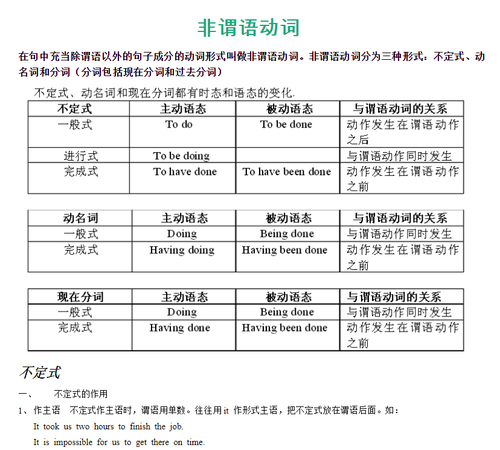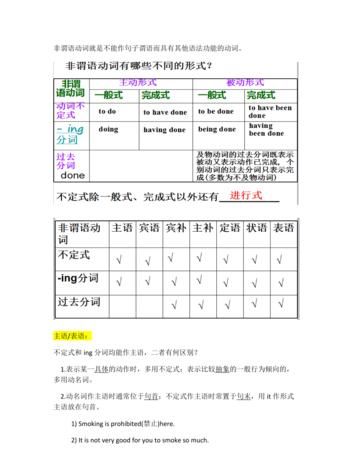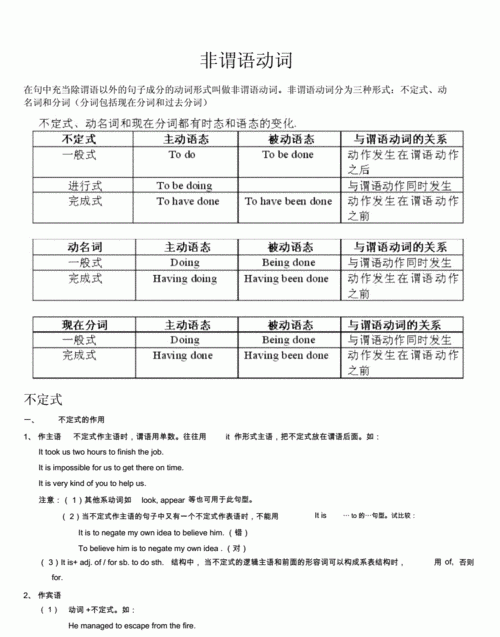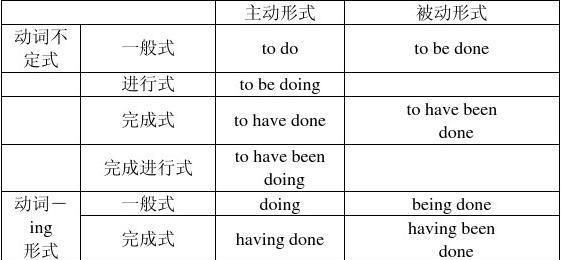本文目录
高中英语非谓语动词知识点总结
非谓语动词首先是一种动词形式,其次是这种动词形式不能做谓语,综合这两点,我们将其叫做非谓语动词。下面我给大家分享一些高中英语非谓语的知识,希望能够帮助大家,欢迎阅读!
高中英语非谓语的知识1
非谓语动词的形式
非谓语动词包含四种形式,即不定式、动名词、现在分词和过去分词。其中,每种形式按照发生时间和主被动又包括不同的子形式。具体如下:
1. 不定式
①基本形式:to do(表示主动,并且一般表示将来)
②被动式:to be done(表示被动,并且一般表示将来)
③进行式:to be doing (表示主动和进行)
④完成时:to have done(表示主动和完成)
⑤完成被动式:to have been done(表示被动和完成)
⑥完成进行式:to have been doing (表示主动和完成进行)
The teacher told us to do morning exercises.
老师让我们做早操。
The car to be bought is for his sister.
要买的这辆车是给他的姐姐的。
She pretended to be reading when the teacher came into the classroom.
老师进来时,她假装正在读书。
The thief is said to have escaped.
据说小偷已经逃跑了。
The thief is said to have been arrested.
据说小偷已经被抓住了。
She is said to have been working in the factory over the last 20 years.
据说在过去的20年里,她一直在这家工厂工作。
2. 动名词
①基本形式:doing (表示主动)
②被动式:being done(表示被动)
③完成式:having done(表示主动和完成)
④完成被动式:having been done(表示被动和完成)
Travelling in space by ordinary people will be common in the future.
在未来,普通人在太空旅行将会是普遍的事情。
Freddy and his band could go nowhere without being followed by their fans. Freddy
和他的乐队到哪里都被他们的粉丝跟着。
I have no idea of his having done such a thing against you.
我不知道他做过这样一件违背你的事情。
Many customers complain of having been given short weight at that shop.
很多顾客抱怨在那家商店被缺斤少两过。
3. 现在分词
①基本形式:doing (表示主动和进行)
②被动式:being done(表示被动和进行)
③完成式:having done(表示主动和完成)
④完成被动式:having been done(表示被动和完成)
He sat there,reading a newspaper.
他坐在那里,读着一张报纸。
The area being studied may be rich in coal.
这个正在被研究的地方可能富含煤。
Having finished my homework,I began to watch TV.
完成作业后,我开始看电视。
Having been told many times,she still can t remember it.
已经被告诉了很多次,她仍然记不住。
4. 过去分词:done
及物动词的过去分词表示被动或完成;不及物动词的过去分词表示主动或完成。
polluted river 被污染的河流;fallen leaves 落叶
注意:非谓语动词本身不能表示现在和过去。非谓语动词表示进行、将来和完成时是相对于谓语动作来说的:和谓语动作同时发生表示进行;发生在谓语动作之后表示将来;发生在谓语动作之前表示完成。
高中英语非谓语的知识2
非谓语动词的语法
非谓语动词除去不能做谓语之外, 其它 所有成分都可以做。具体如下。
1. 不定式:做主语、宾语、表语、定语、状语和补语。
To learn a foreign language is difficult .(作主语)
学会一门外语是很难的。
It’s easy to see their aunt.(作真正主语,it做形式主语)
很容易见到他们的姑姑。
Tom wanted to have a cup of beer.(作宾语)
汤姆想要喝杯啤酒。
His wish is to be a driver.(作表语)
他的愿望是当一名司机。
I have nothing to say.(作定语)
我没有什么可说的。
The teacher told us to do morning exercises . (作宾语补足语)
老师让我们做早操。
They went to see their aunt. (目的状语)
他们去见他们的姑姑。
2. 动名词:做主语、宾语、表语、定语和补语。
Learning English is very difficult .(作主语)
学英语非常困难。
I enjoy dancing.(作动词宾语)
我喜欢跳舞。
I have got used to living in the country.(作介词宾语)
我已经习惯了住农村。
His job is driving a bus.(作表语)
他的工作是开车。
3. 现在分词:做表语、定语、状语和补语。
The story is interesting.
这个 故事 有趣。
He sat there,reading a newspaper.(作状语)
他坐在那里,读着一张报纸。
The area being studied may be rich in coal.(作定语)
这个正在被研究的地方可能富含煤。
He saw the thief stealing some money from the bank.(作宾补)
他看到小偷正在从银行偷钱。
4. 过去分词:做表语、定语、状语和补语。
He is interested in the news.(作表语)
他对这则消息很感兴趣。
polluted river(做定语)
被污染的河流
Given more time,I can do my work better.(做状语)
如果再被多给些时间,我会把工作做得更好。
I found my watch stolen.(做宾补)
我发现我的手表被偷了。
高中英语非谓语的知识3
非谓语动词重、疑、难点
1. 须用省去to 的不定式(do)作宾补的11个动词。
五看(see、watch、notice、observe、look at)
两听(hear、listen to)
三使(make、let、have)
一感觉(feel)
根据谐音记忆法,我们可以记做“吾看两厅三室一感觉”。
I saw a big bird fly over the roof of the house yesterday.
昨天,我看到一只大鸟飞过了屋顶。
注意:以上11个动词,也可以接现在分词和过去分词作宾补,但在时间和语态上会有变化,我们以see为例来区分一下。
see sb. do sth. 看到某人做了某事
see sb. doing sth. 看到某人正在做某事
see sb./sth. done 看到某人/某物被......
I see him make the phone call.
我看到他打了电话。(他打电话的整个动作我都看见了)
I see him making a phone call.
我看到他正在打电话。(强调看到他正在打电话,并没有看见全过程.)
We often see him surrounded by much work.
我们常常看见他被大量的工作包围着.
2. 只接不定式(不能接动名词)作宾语的25个常用动词
want、would like、wish、help、hope、learn、manage、offer、plan、afford、agree、arrange、ask、beg、care、choose、decide、demand、determine、expect、fear、prepare、pretend、promise、refuse
3. 只接动名词(不能接不定式)作宾语的28个常用动词
practice、consider、enjoy、finish、give up、imagine、keep、put off、risk、suggest、admit、advise、allow、appreciate、avoid、delay、deny、discuss、dislike、escape、excuse、fancy、forbid、mention、 mind、miss、permit、prohibit
4. 既可接不定式也可接动名词,但含义完全不同的8个动词
remember to do sth. 记住要做某事(未做)
remember doing sth. 记得做过某事(已做)
forget to do sth. 忘记去做某事(未做)
forget doing sth. 忘记做过某事(已做)
regret to do sth. 遗憾要做某事(未做)
regret doing sth. 后悔/抱歉做过某事(已做)
try to do sth. 努力做某事
try doing sth. 尝试做某事
mean to do sth. 计划做某事
mean doing sth. 意味着做某事
can’t help to do sth. 不能帮助做某事
can’t help doing sth. 情不自禁做某事
go on to do sth. 继续做另一件事
go on doing sth. 继续做同一件事
stop to do sth. 停下来去做另一件事
stop doing sth. 停下正在做的事情
5. 所有非谓语动词的完成形式都不能做定语,如to have done、to have been done、to have been doing、having done 和 having been done。
高中英语非谓语的知识点相关 文章 :
★ 高中英语非谓语知识点
★ 高二英语非谓语动词知识点的复习资料
★ 高中英语非谓语动词知识点
★ 高中英语语法:解析非谓语动词
★ 非谓语动词的语法知识点详解
★ 高中英语语法知识点
★ 非谓语动词知识点归纳
★ 高二英语非谓语动词的概念
★ 英语非谓语动词知识点
★ 英语高考非谓语动词重点语法

高中英语非谓语知识点总结
非谓语动词就是在 句子 中不能单独作谓语的动词,这样的动词没有人称和数的变化。它包括动词的不定式、V-ing和V-ed三种形式。非谓语动词具有双重性质,它既有动词性质,又有非动词性质。下面我给大家分享一些高中英语非谓语知识,希望能够帮助大家,欢迎阅读!
高中英语非谓语知识1
动词不定式
动词不定式(infinitive)是动词的一种非限定形式,即非谓语动词形式,它有两种形式:一种是“to + 动词原形”构成(to- infinitive);另一种是不带to的不定式,即动词原形(bare- infinitive)。所有行为动词都有不定式形式,其否定式是在不定式前加not。动词不定式(或不定式 短语 )没有人称和数的变化,在句子中不能作谓语。
(一)动词不定式的时态和语态
动词不定式有一般式、进行式、完成式、完成进行式四种时态变化形式,一般式和完成式有被动语态变化形式。
1、不定式的时态意义
不定式的时态是以句中谓语动词的时间为依据的
(1)一般式表示的动作或状态通常发生在谓语动词之后或同时发生。
They made plans to live in Paris. 他们计划住在巴黎。(to live 发生在 made plans之后)
(2)进行式表示其动作正在进行,与谓语动词发生的动作同时进行。
He pretended to be listening to me carefully. 他假装认真地听我讲。
注意:
不定式的进行式常同may, might, can, could, must, need, ought to, should, will, would 等情态动词连用,表示“可能、应当或想必”正在进行的动作。
You oughtn’t to be talking so much. 你不应该说这么多。
He might be reading a novel at that time. 那时他可能正在读小说。
(3)不定式的完成时表达下列意义:
A. 不定式的完成式所表示的动作或状态发生在谓语动词所表示的动作之前。
I am sorry to have kept you waiting. 对不起,让你久等了。
(to have kept发生在I am sorry所表示的时间之前)
She is said to have just completed a novel. 据说她刚完成一部小说。
(to have just completed a novel发生在She is said所表示的时间之前)
B.用在intended, expected, meant, hoped, promised, planned, wished, thought, desired, was, were等词后,不定式的完成式表示未曾实现的愿望、期待、想法、打算或计划等。to have + 过去分词表示动作, to have been表示状态。
I meant to have done the work before Sunday. 我本想星期天前完成这项工作。(没完成)
I was to have been a doctor. 我本打算当个医生。(没当成)
I intended to have come to see you.我本打算来看你的。(但没来)
C.用在seem, appear, thing, consider, believe等后,表示一个动作先于另一个动作发生。
I seem to have seen her somewhere before.以前我好像在那见过她。(see在seem之前发生)
He was believed to have been a reporter.都认为他从前干过记者。
D. 在should(would) like 或should(would)have like后用不定式完成式表示没有实现的愿望。
I should like to have gone with her.我多么愿意和她一起去。(但没去)
I would like to have seen her face when she read the letter.我真想见到她读信时的表情。(但没看到)
(4)不定式的完成进行式表示动作在谓语动词之前发生,而且一直进行着。
He was happy to have been staying with his uncle.他很高兴一直跟他叔叔住在一起。
He looked too young to have been publishing books for six years.他看上去很年轻,不像已经出版了6年书的人。
(5) come + 不定式表示一个动作发生的过程
He will come to understand it in the end.他最终会懂得的。
Later he came to be a famous painter.后来他成了著名的画家。
2、动词不定式的被动语态
如果不定式的逻辑主语是不定式动作的执行者不定式用主动式;如果不定式的逻辑主语是不定式动作的承受者时,不定式用被动语态。
The doctor recommended the room to be aired. 医生建议让房间透透气。
The sports meeting on the weekend has to be put off. 周末的运动会被迫推迟。
3、意义上被动形式上主动的不定式
(1) 在“there be+主语”中,不定式用作定语修饰名词或代词,并同所修饰的名词或代词是逻辑上的动宾关系。
There is no time to lose. 一点时间也不能浪费了。
(2)在“名词(代词)+ be easy(difficult, fit等形容词) + 不定式”结构中,有时尽管主语是动作的承受者,不定式在意义上是被动,形式上却是主动,这时可以看成省略了动词逻辑主语for us, for me , for you 等。
The book is difficult to read. 这本书很难读懂。
He is not easy to get on well with. 他不易相处。
(3)如果不定式逻辑主语是不定式动作的执行者,不定式和它修饰的名词虽然在逻辑上有动宾关系,也必须用主动形式,因为逻辑主语同不定式的关系更为直接。
We’ve got plenty to eat.我们有足够的东西吃。(句子主语We在逻辑上是不定式to eat动作的执行者,不定式to eat和它修饰的名词plenty在逻辑上是动宾关系,用主动形式表示被动意义。)
(4)在too… to 和enough to 结构中,不定式可用主动语态表示被动意义。
The box is too heavy to carry.这个箱子太重了搬不动。
(5)blame的不定式作表语时,用主动语态和被动语态表示被动的意义,但含义不同。
You were to blame. (= you are at fault.)这该怪你。
You were to be blamed.(= You are going to be blamed.)你要受到指责。
(6)something, little, what, much, a great deal等作句子主语,表语为to do时,不定式可用主动语态表示被动意义。
A great deal of work remains to do.还有很多工作要做。
What is to do tomorrow? 明天干什么?
高中英语非谓语知识2
动词不定式的句法功能
动词不定式具有名词、形容词和副词的特征,因此在句中可以作主语、表语、宾语补足语、定语和状语。
1、 不定式作主语
不定式及不定式短语作主语时,为了平衡句子结构,可用it作形式主语,而把真正的不定式后置。
To make a plan first is a good idea. 先制订计划是个好办法。
It is a good idea to make a plan first . 首先制订一个计划是一个好主意。
在下列情况下只宜采用it作形式主语
(1)在疑问句或感叹句中作主语的不定式。
How important it is to master a foreign language!掌握一门外语是多么重要啊!
(2)当句中谓语动词不是be, seem, appear等连系动词时。
It took us 20 minutes to get to the station. 赶到车站花了我们20分钟。
(3)在“it +be + adj. + of + sb. +不定式”结构中。
It's very nice of you to help me with my work. 帮我的工作,你真是太好了。
2、不定式作表语
(1)主语、表语都是不定式,前者是条件,后者是目的或结果。
To learn a language is to use it. 学语言是为了使用语言。
To be kind to the enemy is to be cruel to the people. 对敌人仁慈就是对人民残酷。
(2)主语是duty, plan, wish, hope, idea, purpose等名词。
His wish was to become a scientist. 他的愿望是当一名科学家。
To the doctor ,the most important thing is to save people's lives. 对医生来说,最重要的事是拯救人们的生命。
(3)表示时态发展的结果、预期的结果、不幸的命运或预言。
You are to die at 98.你会98岁去世。
Man is to live a better life in the next century.人类在下一世纪会生活的更好。
(4)表示“同意、安排、命令、决定、劝告、意愿 、禁止”等。
They are to marry next week.(安排)他们下周结婚。
Nobody is to know.(禁止)不应让任何人知道。
You must be patient and persistent if you are to succeed.(愿望)要想成功,就必须有耐力,有毅力。
(5)主语是what引导的名词性从句。
What surprised me most is to see him beaten black and blue. 使我吃惊的是看到他被打得遍体鳞伤。
What is important at present is to save lives.目前救人要紧。
3、不定式作宾语
(1)有些及物动词常跟不定式作宾语,如agree, afford, arrange, ask, begin , decide, forget, hope, like , start , want, wish等。也可用来作形容词的宾语,如able, afraid, anxious, careful, content, determined, eager, foolish, free, glad, inclined, likely, pleased, prepared, ready, slow, sure, sorry, willing等。
She wanted to borrow my bike. 她想借我的自行车。
The boys and girls are anxious to learn how to swim. 孩子们渴望学会 游泳 。
(2)不定式作宾语时,句子的主语是不定式的逻辑主语,与不定式动词的关系是主动关系,但有时不定式和主语却是动宾关系。
English is not difficult to learn.英语不难学。
(3)feel, find, judge, make, think, believe, consider等动词后如果是不定式作宾语,后面有宾语补足语时,将真正的宾语不定式放在补足语的后面,而将形式宾语it放在补语之前。
He found it hard to learn maths.他发现数学很难学。
I think it our duty to support the elder.我认为赡养老人是我们的义务。
4、不定式作定语
不定式作定语时,需放在它所修饰的名词或代词之后。它与所修饰的名词或代词有下列关系:
(1)动宾关系
如果不定式的动词是不及物动词,和所修饰名词搭配的介词不能省略。
Have you got anything to say?你有什么要说的吗?
He had no room to live in.他没房子住。
(2)主谓关系
He is always the first to come and last to leave.他总是第一个来,最后一个走。
The next train to arrive is from Washington.下一列到站的火车是从华盛顿开来的。
(3)同位语关系
The farmers thought of ways to protect their crops. 农民们想出保护庄稼的办法。
He had the wish to be an artist. 他愿意当艺术家。
5、不定式作状语
不定式作状语时,常表示目的、结果、原因、条件等,通常放在它所修饰的动词之后。
(1)表目的
不定式作目的状语时,其动作发生在谓语动词之后,一般放在句子后部。但如要表示强调,也可以位于句首,前面可加in order,不定式作目的状语时其否定必须用in order not +不定式,或so as not +不定式。in order to 引出的不定式可置于句首或句中,so as not+不定式不能放在句首,只能放在句中。
He stopped to have a rest. 他停下来休息。(目的)
To search for gold, many people went to California. 为了寻找金子,许多人去了加利福尼亚。(目的)
I often read China Daily so as to improve my reading. 我常读《中国日报》以提高我的阅读。(目的)
We often listen to English broadcasts to/in order to/so as to get listening training. 我们经常听英语广播,以增强听力训练。
(2)表示结果
A.形容词如right, polite, crazy, generous, good, greedy, kind, selfish, silly, splendid, nice, unselfish, unkind等对人进行表扬或批评,后接不定式表示结果,不定式的逻辑主语也就是句子主语。
He is very polite to show us the way.他很有礼貌给我们指路。
He is silly to say so. 他这么说太傻了。
B. 不定式和only连用,表示未预料到的结果。
He woke up only to find himself famous. 他一觉醒来,竟发现自己成名了。
The thief broke into the house only to find it empty. 小偷闯进屋子,却发现是空的。
C.在so… as to, such …as to, enough to等结构中的不定式皆表示结果。
He is too young to join the army. 他太年轻了,不能参军。
He is so careless as to forget his pen.她太粗心了,以至于把钢笔忘了带。
D.“too …to”表示结果意为:太……而不能……,但有时不含否定意义。
He is too excited to sleep. 他太激动了,不能入睡。(否定)
We are only too pleased to work together with you. 我们同你一起工作,真是太高兴了。(肯定)
You are too ready to find out fault with others. 你太好挑剔别人了。(肯定)
(3)表示原因,其逻辑主语是句子的主语。
She wept to see him in such a terrible state.她看到他这种可怕的样子就哭了。
(4)表示条件
动词不定式有时也可以表示条件,一般置于句首,否定不定式表示条件多置于句尾,这时谓语动词常含有will, shall, should, would, can, must等。
To hear him talk, you would think he owned the whole world. 要是听他讲话,你会认为整个世界都是他的。
(5)表明说话人的态度, 在句中作独立成份。
To tell the truth, this all Greek to me.说实话,我对此一窍不通。
To make a long story short, he became bankrupt.简单的说,他破产了。
To be true, we can do it well.当然,我们能做好。
除此之外还有:
to be brief 简而言之、to be exact 精确的说、to be frank with you老实对你说 、to be plain 老实说 、to put it straight直截了当、to bring the story short长话短说、to return to my subject言归正传、to change the subject换一个话题、to use his own words用自己的话说、to make matter worse更糟的是、to give him his due公正地说、strange to say奇怪地说、to say nothing of姑且不讲、to conclude总之、to crown all更好(坏)的是、to be honest直率地说、to start /begin with首先、to do him justice说句公道话、to sum up总之,总而言之等。这些短语大都位于句首,偶尔位于句中或句尾,需要用逗号和其他成份隔开。但表示“更不用说”的几个短语一般要放在句尾,如to say nothing of, not to say, not to mention, not to speak of, let alone, much less, much more 等。
6、不定式作宾语补足语和主语补足语
动词believe, consider, declare, find, prove, suppose, feel, think等后面常跟to be 不定式作宾补。有时to be 可以省略。这类不定式改为被动语态后就变成了主语补足语。感官动词如feel, see, hear, watch, notice, observe, listen to, look at 等以及使役动词make, have, let 等在跟不定式作宾语补足语时省略不定式符号to。但在转换成被动语态时要加上to。
We believe her (to be) innocent.我们相信她无罪。
He was heard to sing next door.有人听见他在隔壁唱过歌。
She made the boy go to bed early.她让那个男孩早睡觉。
The boy was made to go to bed early.那个男孩被迫早睡觉。
高中英语非谓语知识3
(三)动词不定式的否定式
不定式的否定式由“not+动词不定式”构成。
Tell him not to be late. 告诉他不要迟到。
The policeman told the boys not to play in the street. 那位警察告诉那些男孩们不要在街上玩。
(四)动词不定式的复合结构
1、for+名词或代词+不定式
不定式的复合结构由“for+名词或代词+不定式”构成。这个名词或代词形式上是for的宾语,而意义上是不定式的逻辑主语。这种结构可在句子中作主语、宾语、表语、定语、状语等。如:
It is necessary for us to learn from each other. 我们相互学习是必要的。(主语)
I think it a good idea for her to study medicine. 我认为她学医是个好主意。(宾语)
The engine is for you to repair. 这台发动机归你修。(表语)
The lake is a good place for you to swim in. 这湖是你游泳的好地方。(定语)
I spoke slowly for them to make notes. 我讲得很慢以便让他们作笔记。(状语)
2、“It is + 形容词+X +代词(名词)+不定式”句型——用of 还是用for
(1) 如果句中的形容词表示人物特征或品质,常同of搭配构成“It is + 形容词+of+代词(名词)+不定式”句型。如:bold ,brave, careful, careless, considerate, cruel, rude, generous, :right,wrong, kind,nice,good,polite,clever,wise, foolish, silly等。这是一个带有感情色彩的不定式结构, 表示好意时,具有“对……不胜感激”的意思;表示坏的意思时,含有“真是太……,真是……透了”的意思。
It is kind of you to help me.你帮助我真是太好了。
It was foolish of us to do so.我们这样做真是太傻了。
这一结构均可改为“主语+be+形容词+不定式”但无感情色彩。
You are kind to help.你帮我很好。
We are foolish to do so.我们这样做傻。
(2)表示事物性质的形容词如easy, difficult, hard, important, impossible, possible, safe, dangerous, necessary常同for 搭配,构成“It is + 形容词+for+代词(名词)+不定式”句型。这类形容词同for后的名词或代词关系不密切,没有意义上的主表关系,但与句中的不定式结构关系密切,有意义上的主表关系。
It’s difficult for me to work out the problem.我要算出这道题目太难了。
It’s very important for students to learn English well.对于学生们来说,学好英语是很重要的。
注意:这类形容词easy, convenient, dangerous, difficult, lazy, weak, hard, important, impossible, possible, safe, necessary, troublesome等,一般不能用于“人称代词(it除外)+be+形容词+不定式”结构中。试比较:
It is impossible for me to finish it today.我今天不可能完成这项工作。
不能用I am impossible to finish it today.
Come and see me whenever it is convenient to you.方便的时候来看我。
(五)动词不定式和疑问词连用
(1) 关系词+动词不定式
动词不定式可以和疑问代词:who, what, which 及疑问副词:when, where, how, why等连用,构成不定式短语,在句中作主语、宾语、表语等成份。如:
Who to do the work has not been decided yet. 谁干这项工作尚未决定。(主语)
He showed me how to use a computer. 他向我示范了一下怎样使用计算机。(宾语)
(2)“with + whom/which + 不定式”结构
“with + whom/which + 不定式”结构是一种简洁的表达方式,指人时用whom,指物时用which,这种结构中的with有时可以是by, through, on, from等。这种结构通常用作后置定语。
She had only 15 dollars with which to buy her husband a gift. 她只有15美元,用它来给她丈夫买礼物。
She is a nice woman with whom to work.她是一个很好的工作同伴。
He opened the north window from which(where) to enjoy the distant hill. 他打开北窗,从那里可以欣赏到远处山的景色。
高中英语非谓语知识点相关 文章 :
★ 非谓语动词知识点归纳
★ 高二英语非谓语动词的概念
★ 高二英语非谓语动词复习题
★ 高考英语重点知识点
★ 高考英语复习知识点:动词和动词词组及非谓语动词
★ 高三英语语法知识点归纳
★ 高考英语知识点考点归纳
★ 高考英语语法填空代词知识点与非谓语动词之分词表
★ 高考英语语法知识点
★ 高考英语知识点整理最新

高中英语非谓语动词讲解视频
1.这个是非谓语动词中的独立主格结构,也就是说非谓语动词有他自己的逻辑主语。
整个句子的主语是 I ,而 treat 的主语是you,you与treat是主动关系,所以是treating
2.过去分词做状语,省略了主语the two students 和be动词were(与后半句主谓一致),所以直接填Lost就行
3.and前后要连接两个并列结构,即no……for/to……

英语高考非谓语动词真题
2011年高考英语第二轮热点专题复习——非谓语动词
规律方法
1.考查立意较低,主要考查的是非谓语的一些最基本的用法。但是,题目的设置注重了情景化和结构复杂化,加大了考生对题干句的理解难度。
2.设问的角度呈现出多样化趋势,不仅仅是非谓语间的互相干扰。
命题趋势
不容置疑,高考将继续加强对非谓语动词的考查,试题的特征将继续呈现出“情景化”和“设问角度的多样化”的趋势,但试题的难度将会有所控制。
突破方法
1.非谓语动词的用法是一个系统性、综合性很强的语言点,切不可记住几个条条框框就去乱套。真正领悟非谓语动词的用法要具备以下基础知识:
① 具有句子结构的知识,要分得清简单句与复合句,陈述句与祈使句。
② 具有简单句最基本的五种句型的知识,要分得清双宾语和复合宾语。
③ 具有扎实而丰富的动词知识,要分得清及物动词和不及物动词,双宾动词和复宾动词。一些最基础最常用的动词的用法应当烂熟于胸。
④ 具备各种复合句的知识,能够拆析30词左右长度的复合长、难句。
2.理解分析非谓语动词的句法功能,重点掌握不定式、动名词作宾语的区别;不定式、分词作补语的区别;不定式、分词作状语的区别;独立主格的用法;不定式、分词作定语的区别。
3.解答考查非谓语动词的题目时,一定要保持头脑冷静。一般要遵循以下解题思路:
① 解析句子结构,确定设空在句子中充当的功能(如状语、定语或宾补);
② 找准相关动词的逻辑主语,确定该动词与逻辑主语是什么关系(主动还是被动);
③ 搜索句子中相关的时间信息,确定非谓语动词的恰当形式;
④ 将该选项置入空中,看是否能够做到字从意顺,或是否能传达有效信息、完成交际任务。
知识清单
清单一 非谓语动词的句法功能
名称 主语 宾语 宾语补足语 表语 定语 状语
不定式 √ √ √ √ √ √
动名词 √ √ √ √
现在分词 √ √ √ √
过去分词 √ √ √ √
清单二 分词、不定式作宾补用法要点
一、分词、不定式作宾语补足语的区别
1.感官动词see, watch, observe, look at, hear, listen to, notice 等和使役动词have 后面的宾补有三种形式,即原形动词(不带to 的不定式)、现在分词和过去分词。现在分词表主动或正在进行,过去分词表被动或完成,动词原形表主动和完成。如:
I heard her sing an English song just now.
刚才我听见她唱了一首英文歌。
I heard her singing and English song when I passed by her room yesterday.
昨天经过她房间时,我听见她在唱英文歌。
I heard the English song sung many times.
我多次听到有人唱这首英文歌。
注意:不及物动词的过去分词作宾补表完成和状态。如:
I looked down at my neck and found my necklace gone. (状态)
I was surprised to find my hometown changed so much. (完成)
2.leave 后接三种形式作宾补时,其中的leave 保留了原来之义“留下”,但表达的确切之义应是“使……处于某种状态)。
leave sb. doing sth. 让某人一直做某事
(宾语和宾补之间是主谓关系,表示动作正在进行。)
leave sth. undone 留下某事未做
(宾语和宾补之间是动宾关系,表示被动和完成,一般以undone, unfinished, unsettled, untouched 为多)
leave sb. to do sth. 留下某人做某事
leave sth. to be done 留下某事要做
(不定式表示将来的动作。)
如:It’s wrong of you to leave the machine running.
你让机器一直开着是不对的。(主动,正在进行)
The guests left most of the dishes untouched, because they didn’t taste delicious.
客人们没有动大部分菜,因为它们尝起来不可口。(被动,完成)
He left, leaving me to do all the rest work.
他走了,留下我一人去做剩余的工所有工作。(主动,将来)
We hurriedly ended our meeting, leaving many problems to be settled.
我们匆匆忙忙导结束了会议,留下了很多问题等待解决。(被动,将来)
3.have, get 后接三种形式作宾补时,其中heave, get 表示“使、让、叫”之意。
① have sth. dOne= get sth. done “使/让某事由别人去做”(叫/让某人做某事)。如
I’ll have /get my bike repaired tomorrow.
此外,have sth. done 还表示“使遭受……”之意。如
Tom had his leg broken while playing football.
Mr. Smith had his house broken into while he was away on holiday.
② have sb. / sth. doing 使/让某人/物持续地做某事(现在分词表示主动,正在进行)
get sb. / sth. doing 使某人/物开始行动起来
如:The peasants had the tractor working day and night at the harvest time.
农忙时,农民们让拖拉机夜以继日地干活。
The captain got the soldiers moving toward the front after a short rest.
休息了片刻之后,上尉让士兵们开始朝前线行进起来。
注意:“have sb. doing”若用于否定句中,其中have 有“容忍”之意。如:
I won’t have you speaking to your parents like that.
我不会让你那样子跟你的父母说话。
Don’t have the water running all the time.
不要让水流个不停。
③ have sb. do sth. (get sb. to do sth. ) 使/让/叫某人去做某事
如:Mother had me go to the shop and buy some salt.
I can’t get him to stop smoking. He won’t listen to me.
二、下列动词后跟带to 的不定式作补语:
advise, allow, ask, beg, cause, encourage, expect, forbid, force, get, intend, invite, like, love, order, persuade, prefer, require, teach, tell, want, warn, wish, think, wait for, call on, depend on 等。如:
① An army spokesman stressed that all thd soldiers had been ordered to issue clear warning before firing any shots.
② The teacher asked us not to make so much noise.
③ The flu is believed to be caused by viruses that like to reproduce in the cells inside the human nose and throat.
三、不定式、现在分词作宾补小窍门
下列动词后在主动语态中用不带to 的不定式作补语,但在被动语态中要加上to:
它们是“吾看三室两厅一感觉”——5看(look at, see, watch, notice, observe);3使(make, let, have);2听(listen to, hear);1感觉(fell)。以上动词还可用现在分词作宾语补足语(5+3+2+1-2+4):即以上动词除let, make 外都可以用现在分词作宾语补足语,此外find, catch, keep, lave 也可以用现在分词作宾语补足语。如:
At that time, I found him crying in the street.
He was caught stealing.
I’m sorry to have kept you waiting for such a long time.
The missing boys were last seen playing near the river.
清单三 不定式、分词作定语用法要点
一、不定式作定语
1.作定语的不定式如果是不及物动词,或者不定式所修饰的名词或代词是不定式动作的地点、工具等,不定式后面须有相应的介词。如:
The Browns have a comfortable house to live in.
There is nothing to worry about.
Please give me a knife to cut with.
Here is some paper for you to write on.
但是,不定式所修饰的名词如果是time, place 或way时,不定式后面的介词习惯上省去。如:
He had no money and no place to live (in).
We found a way to solve this problem (in).
2.当作定语的不定式所修饰的名词或代词是不定式动作的承受者时,不定式既可以用主动语态,也可用被动语态,但其含义有所不同。试比较:
Have you anything to send ? 你有什么东西要寄吗?
(不定式to send 的动作执行者是“你”)
Have you anything to be sent ? 你有什么要(我或别人)寄的东西吗?
(不定式to be sent 的动作执行者是“我”或“别人”)
3.用不定式作定语的几种情况:
不定式表将来:
I borrowed some books to read during my holiday.
用来修饰被序数词、最高级或no, all, any 等限定的中心词。如:
He was the best man to do the job.
She was the first woman to sin the gold medal in the Olympic Games.
Women and children were the first to get into the lifeboats.
用来修饰的词是抽象名词时,常见的有:ability, chance, idea, fact, excuse, promise, answer, reply, attempt, belief, way, reason, moment, time 等。如:
Do you have the ability to read and write English ?
I have to chance to go sight –seeing.
二、分词作定语
1.作定语的及物动词分词形式为:V –ing; being + 过去分词;过去分刻画 。当被修饰的名词与分词为主动关系时,用V –ing;当被修饰的名词与分词为被动关系且表正在进行时,用being + 过去分词;当被修饰的名词与分词为被动关系且表完成时,用过去分词。例如:
The houses being built are for the teachers.
The broken glass is Tom’s.
I have never seen a more moving movie.
2.作定语的不及物动词分词形式为:V –ing 和过去分词。V –ing 表示正在进行;过去分词表示已经完成。如:
falling leaves 正落的叶子 fallen leaves 落下的叶子
boiling water 正沸腾的水 boiled water 沸腾过的水(白开水)
三、不定式、过去分词和现在分词被动式作定语的区别
这三种形式作定语,主要是体现在动作的发生时间上。过去分词表示的动作或是在谓语所表示的动作之前发生,或是没有一定的时间性。如:
Have you read the novel written by Dickens ?
He is man loved and respected by all.
Don’t use words, expressions, or phrases known only to people with specific knowledge.
现在分词的被动式作定语时表示的动作正在发生或是与谓语动词所表示的动作同时发生。如:
Listen ! The song being sung is very popular with the students.
不定式的被动式作定语时,表示一个未来的动作。如:
The question to be discussed at the tomorrow’s meeting is a very important one.

以上就是关于高中非谓语动词知识点题目,高中英语非谓语动词知识点总结的全部内容,以及高中非谓语动词知识点题目 的相关内容,希望能够帮到您。

